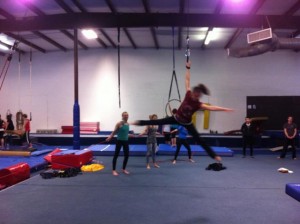The following article is from one of the awesome aerial instructors in our teacher directory, Heather Hammond. Heather is Chief Entertainment Officer and Head Instructor at Heliummm Aerial Dance & Entertainment in New York City. She recently coached and added new aerial choreography to Lincoln Center’s Monkey: Journey to the West. www.heliummm.com for more info.
A concerned lyra student asks: Mama Silk, how can I not toss my cookies when I start spinning? I almost threw up on the subway platform after lyra class last week. Help!
Good question, concerned student! The short answer regardless of apparatus is: build up slowly, and practice till you get your sea legs (I mean your air legs). But let’s investigate the spin phenomenon a little closer:
WHY DOES SPINNING MAKE YOU SICK?
Your brain gets information on its position in space from visual (eyes), kinesthetic (touch) and vestibular (inner ear) sources. When conflict arises from what you see, what you feel and what your brain perceives, you end up feeling crappy.
With respect to your ears, there are three of semi-circular canals in each ear, one for each plane of movement (up/down, left/right, front/back). These fluid-filled canals in your head tell you which way is up and which way is left and right so you know if you’re standing up or lying down.

When you spin, the fluid in these canals will spin around. If you stop suddenly, your body stops, but the fluid in your ears is still going. You think you’re still spinning, but your eyes are telling you that you’re not spinning. Your brain gets very confused and you feel sick. And, the ’tilt and rotate’ combination frequently used in aerial choreography is extremely challenging for the brain’s processing systems. The scientists call it ‘aberrant vestibular inputs’. Tourists call it “Stop slamming on the brake, cabbie!” Aerialists call it ‘Oh, my God! I’m so barfy!”
Scientists think some of these phenomena may harken back to our caveman days. The same inner ear balance mechanism that is responsible for seasickness also handles the body’s ability to detect ingested poison; the signals sent to the brain when a person is spinning or seasick are the same as those sent when a person has eaten something dangerous, and the body’s protective response to poison is vomiting. Therefore, when you’re seasick, you vomit. Same goes for smells. I always feel worse at shows with lots of sensory overload: flashing lights, loud music, food odors (or worse, somebody else’s body odor), diesel fumes from generators, etc, are likely to make me feel more barfy.
PREVENTION
- Freshen your breath.
I got this tip from an old boyfriend who was a bosun with the Canadian Navy. If it works for the sailors, it can work for us aerial beauties.
Keep a small travel toothbrush in your training bag, or some sugarless gum so you’re all minty before you spin. [Remember to spit the gum out BEFORE class.]
- Smell something pleasant.
Keep a small handkerchief that’s been scented with lavender oil, or some other smell you associate with comfort. Breathe in the scent to help clear your channels. Move away from strong odors. [Or nicely tell your classmate to please go buy some anti-perspirant].
- Train yourself to ignore your brain.
With repeated practice, you can train your brain to ignore the conflicting input it’s getting from your fabulous aerial gyrations. Astronauts do it, and so can you.
Start by spinning slowly, right side up, then upside down, WITH YOUR HEAD IN A FIXED POSITION. Look at something stationary, like your hand, or the lyra.
Then repeat, with a soft focus, and then with roving eyes, right side up and upside down. Add head tilts, and finally head rotations while you’re spinning.
With repeated practice, you’ll find the method that works best for you. Some people swear by staring at a fixed point. Others prefer a soft focus, or even closing their eyes. I have a straps routine that involves orbiting and spinning and inversions and head tilts all at the same time. When I haven’t done the routine in a while, I always get a little barfy the first few times I rehearse until I get my sea legs again.
- Stay hydrated
Keep your fluid intake high. Water is best. Avoid de-hydrating drinks like coffee, Red Bull.
 Don’t come to class, rehearsal or performance hung over. It’s unprofessional and dangerous.
Don’t come to class, rehearsal or performance hung over. It’s unprofessional and dangerous.
- Eat Right and Light
Eat light, easily digestible food before rehearsal or performance. Time it so you’ve digested before turning upside down. Avoid fatty, spicy stuff, unless you’re OK with the consequences.
- Spin at the end of class or rehearsal
Save the spinning until the end of class or rehearsal. This way if you do get naseous, you’ve already worked on stuff.
TREATMENT
Prevention is really the best medicine. Once you feel like crap, it can take a while to come back to normal.
- Candied ginger
Delicious and nutritious (except for all that sugar). Keep a bag handy, and indulge as needed.
- ‘Unspin’
When you touch ground, step off the mat and away from the apparatus and turn in the opposite direction to unwind. Or spin slowly a couple of times in the reverse direction.
- Hop
Hop up and down while staring a fixed spot on the wall. This may settle the liquid in your ears, and align the physical and visual input.
- Lie down
Sometimes I just like to lie down on my back, with my knees bent and my feet flat on the floor.
- Dramamine
Spinning stimulates the cholinergic system, producing: sweating, increased stomach acid, a desire to, um, ‘go’.
Dramamine is now available in two forms: dimenhydrinate and meclizine. Both are anti-histamines that help reduce the cholinergic reaction. Take as directed on the package – they can cause drowsiness, so don’t down it for the first time before driving to your gig, or right before you perform. See how you do on it in an un-pressured setting, first. And no post-ingestion imbibing, unless you’re taking the subway home.
- Antacids
Keep a roll of Tums or Rolaids in your bag. Zantac and Pepcid are other good choices.
What works for you?
Mama Silk is always looking for new tips and tricks. Let us know what works best for you, so we can share it!
So spin, my darlings, spin. And create many beautiful things.
Love,
Mama Silk (and Lyra)



